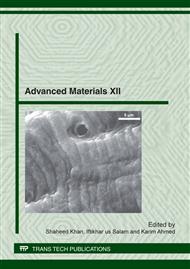[1]
S. Masounave and J. P. Bailon, Scripta Metallurgica, Vol. 9, 1975, pp.723-730.
Google Scholar
[2]
M. Okayasu, K. Sato M. Mizuno, D.Y. Hwang and D.H. Shin, Int. J. Fatigue, 30, 8, 2008, pp.1358-1365.
Google Scholar
[3]
A.B. El-Shabasy, and J. J. Lewandowski, Inter. J. Fatigue, 26, 3, 2004, pp.305-309.
Google Scholar
[4]
K. Masao, S. Etuso, O. Akihiko and K. Michio, Trans, National Research Inst. Metal 1985, Vol. 27 No. 2, pp.97-113.
Google Scholar
[5]
J. Andersson, Inter. J. Fatigue, 27, 8, 2005, pp.847-852.
Google Scholar
[6]
P. K. Liaw T. R., Leax, V. P. Swaminathan and J. K. Donald Scripta Metallurgica, 1982, Vol. 16, pp.871-876.
DOI: 10.1016/0036-9748(82)90247-2
Google Scholar
[7]
W. F. Brown, Jr. and J. E. Srawley, ASTM STP 410, 1966, p.12.
Google Scholar
[8]
R. O. Richie, Metal. Science, 1977, 11, pp.368-381.
Google Scholar
[9]
M. T. Xu. T. H. Topper, J. Eng. Mat. And Tech., Vol. 107, 1985, pp.19-25.
Google Scholar
[10]
D. L. Chen, Z. G. Wang, X. X. Jaing, S. H. Ali and C. H. Shih, Basic Mechanism in Fatigue of Metals P. Lakas and J. Polak, 1988, pp.12-14.
Google Scholar
[11]
J. Masounave and J. P. Bailon, Scripta Metallurgica, 1976, Vol. 10, pp.165-170.
Google Scholar
[12]
M. F. Carlson and R. O. Ritchie, Scripta Metallurgica, 1977, Vol. 11, pp.113-118.
Google Scholar
[13]
J. P. Lucas and W. W. Gerberich, Mat. Sci. and Eng. 1981, Vol. 51, pp.203-212.
Google Scholar
[14]
J. P. Benson, Met – Sci. 1979, Vol. 13, p-535.
Google Scholar
[15]
F. George Vander Vourt, Practical Applications of Quantitative Metallography, ASTM, 839, 1984, pp.85-131.
Google Scholar
[16]
J. A. Wasynchzuk, R. O. Ritchie and G. Thomas, Mater. Sci. Eng. 01. 62, 1984, pp.79-93.
Google Scholar
[17]
M. K. Tseng, I. Jiang and Z. H. Lai, Fatigue Prevention and Design, Amsterdam 1986, pp.21-24.
Google Scholar
[18]
J. Masounave and J. P. Bailon, Scripta Metallurgica, 1975, Vol. 9, pp.723-730.
Google Scholar
[19]
W. W. Gerberich and N. R. Moody, ASTM spec. Tech. Publ. 675, 1979. p.292.
Google Scholar
[20]
R. O. Ritchie, in proc, Int. Conf. On Analytical and Experimental Fracture Mechanics, Rome, (1980).
Google Scholar


